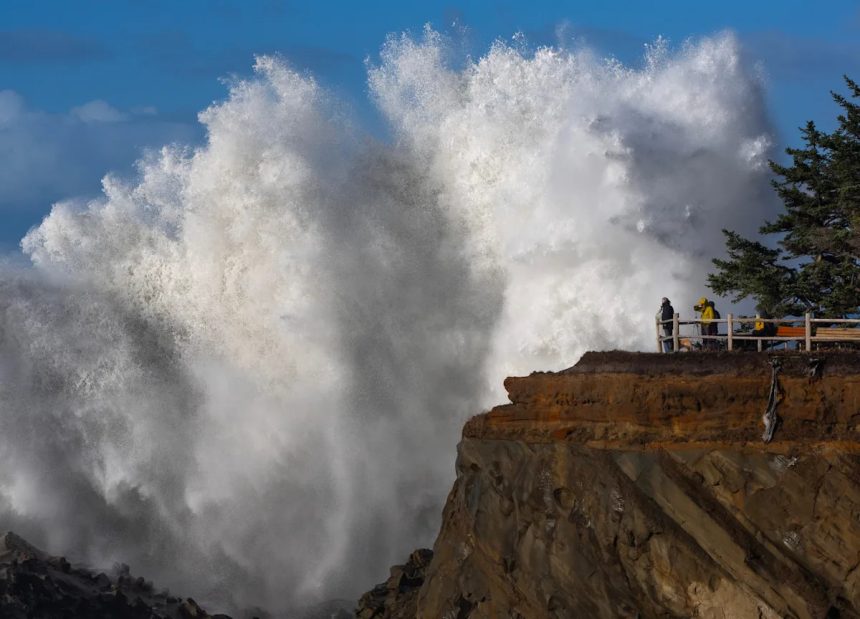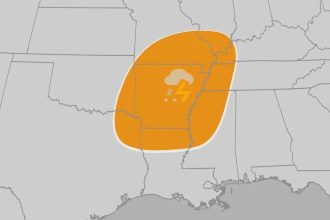King tides are returning to the Oregon Coast on Nov. 5, officially kicking off the 2025-26 king tide season.
The name king tides refers to the highest tides of the year, which occur in late fall and during winter in Oregon. When they happen, beaches can become completely covered by incoming tides and large waves are known to explode off seawalls, cliffs and rocks.
King tides are also known to lure people to the coast, especially storm watchers and photographers, Dan Hagg, director of trails and outdoor recreation for Tillamook Coast Visitors Association, previously said. Beachcombers often love exploring the sand after the high tides, because of the extra ocean treasures that wash up.
But the tides also come with increased risk and danger.
The Oregon Coast will have king tides three times during the 2025-26 season, with the first ones occurring for three days from Nov. 5-7.
Here’s what to know about the king tides.
Visitors watch waves crash on the rocky shore from a bluff at Shore Acres State Park southwest of Coos Bay during a king tide in 2024. The first king tides of the 2025-26 season are set to happen Nov. 5-7.
What are king tides?
King tides are higher-than-average tides that happen when the moon’s orbit comes closest to the earth and when the earth’s orbit is closest to the sun.
The tides can also happen when the sun, moon and earth are in direct alignment. This occurrence increases their gravitational influence on the tides, according to Hagg.
When will king tides occur during the 2025-26 season?
The 2025-26 king tides will happen Nov. 5-7, Dec. 4-6, and Jan. 1-4.

A sign warns visitors to stay back as waves crash on the rocky shore at Shore Acres State Park southwest of Coos Bay during a king tide in December 2024.
How can I watch king tides safely?
The Oregon Parks and Recreation Department, which manages the coastal beach, had two primary suggests for watching the tides safely.
-
Watch from a distance. Look for locations well above the action and away from cliff edges. Don’t let the parking lot fool you. Just because it seems relatively safe, it doesn’t mean the nearby trails and beaches are safe. Avoid being on the beach during a storm or king tides. Jetties are not a safe place to watch.
-
Mind fences and safety barriers. Respect all fences, cones, caution tape and other safety barriers. Park rangers carefully plan trails and install fences and barricades to keep visitors safely away from crumbling cliff edges, unstable hillsides and dangerous trail hazards. Crossing barricades and venturing near cliff edges puts you in danger of slipping and falling down cliffs, even in the best of weather.
Where are good places to watch king tides on the Oregon Coast?
OPRD had the following suggestion for places to watch king tides.
OPRD didn’t specifically call these places out, but they are popular for viewing king tides:
-
North coast: Graveyard of the Pacific, Haystack Rock and the Promenade at Seaside
-
Central coast: The Spouting Horn, Seal Rock, Depoe Bay
-
South coast: Shore Acres State Park

People crowd the ocean overlook to watch waves crash against the rocks below during king tides at Depoe Bay on Jan. 11.
Searching for treasure after the king tides
When the king tides roll back and it’s safe to explore the beach again, a bonanza of ocean treasure can often be found. Agates, shells, petrified wood and other treasures are washed onto the beach by the powerful tides.
OPRD again warned visitors to be cautious.
“One of the best times to explore the beach is just after a storm when the waves have washed up new ocean treasures,” Stefanie Knowlton, spokeswoman for OPRD, previously said. “But don’t be fooled by the calm seas. Driftwood piles are always unsteady and particularly after a storm. Trails you used yesterday may be washed out or degraded.”
What is the Oregon King Tides Project and why are king tides being studied?
The Oregon Coastal Management Program and CoastWatch program of the Oregon Shores Conservation Coalition worked together to create the Oregon King Tides Project.
The Oregon King Tides Project seeks to understand how high tides are affecting the coastline, especially low-elevation areas of the Oregon Coast already susceptible to damage from high water levels.
Because “rising sea levels means increased erosion and more frequent and expanded flooding in the future,” the project emphasizes how crucial it is to understand and document the way higher tides are impacting the coast.
Coastal communities can use this information to protect themselves from rising sea levels.
How to participate in the King Tides Project
The King Tides Project will be holding a photo contest of king tides photos during the 2025-26 season.
People witnessing king tides are encouraged to photograph incoming waves along Oregon’s beaches, coastal waterways, public infrastructure and their properties. These photographs “help to visualize and understand the impacts of sea level rise,” according to the King Tides Project.
The Oregon King Tides Project has provided a tide map detailing where and when the highest tides are occurring.
People can submit their photographs to the King Tides Project website where they will be considered under categories including coastal flooding, coastal erosion and waves, bays and estuaries, and youth photographers for children under 18 who want to submit their photos.
Winners will be picked in February to receive prizes. People hoping to participate can take a look at the King Tides Project photo gallery to see examples and comparisons of king tides.
Ginnie Sandoval is the Oregon Connect reporter for the Statesman Journal. Sandoval can be reached at GSandoval@gannett.com or on X at @GinnieSandoval.
This article originally appeared on Salem Statesman Journal: King tides returning to Oregon Coast Nov. 5-7. Here’s how to see them









